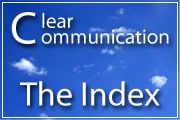At a glance
Health professionals have a responsibility to make sure health information is usable and understandable by audiences. The guidance and tools on this page can help make your health information accurate, accessible, and actionable.
Communication guidance
Accessible Digital Content: Tips and Tricks (U.S. General Services Administration, Technology Transformation Services) In this 2021 webinar recording, the presenters bring attention to some of the common accessibility mistakes that people make when developing digital content, show attendees how to fix them, and demonstrate how to create a product that's accessible from the start.
Clear Communication: An NIH Health Literacy Initiative (National Institutes of Health): NIH has established the Clear Communication initiative that focuses on achieving two key objectives of health literacy: Providing information in the form and with the content that is accessible to specific audiences based on cultural competence and incorporating plain language approaches and new technologies.
NIH National Cancer Institute "Pink Book" – Making Health Communication Programs Work (National Cancer Institute): This book describes a practical approach for planning and implementing health communication efforts. It covers a range of topics, from planning and strategy development, to pretesting materials, to implementing the campaign, to evaluation.
Material assessment tools
Clear Communication Index (Centers for Disease Control and Prevention): The CDC Clear Communication Index (Index) is a research-based tool to plan and assess public communication materials. The Centers for Disease Control and Prevention (CDC) developed the Index to identify the most important factors that increase clarity and aid understanding of public messages and materials.
Clear Writing Assessment (National Center for Environmental Health/Agency for Toxic Substances and Disease Registry): The Clear Writing Assessment focuses primarily on grammar and mechanics to help you write clearly. Answer 16 questions about your material and use the score to determine if your document needs further revisions. A user guide helps explain the importance of all 16 items in the assessment tool.

Plain language materials and resources
Plain language makes it easier for everyone to understand and use health information. Although plain language is a familiar idea, many organizations don't use it as often as they should. The Plain Writing Act of 2010 requires federal agencies to train staff and use plain language when they communicate with the public.
Web communication guidance
Health Literacy Online Guide (Department of Health and Human Services): This guide is written for web designers, content specialists, and other public health communication professionals. The guide offers an overview of how to deliver online health information that is actionable and engaging, create a health web site that's easy to use, particularly for people with limited literacy skills and limited experience using the web, and evaluate and improve your health Web site with user-centered design.
Usability.gov (Department of Health and Human Services): Usability.gov is a one-stop source for government web designers to learn how to make websites more usable, useful, and accessible. The site addresses a broad range of factors that go into web design and development. The site will help you to: Plan and design usable sites by collecting data on what users need, develop prototypes, conduct usability tests and write up results, and measure trends and demographics.
Tips to improve your materials
Pictures that are closely linked to written or spoken text and have minimal distracting details can be helpful to individuals with low literacy skills. For evidence of how adding pictures to written and spoken language can increase the effectiveness of health education materials see the following:
Just as written material can be made more reader-friendly, orally delivered health information can be made more accessible and actionable. For evidence of how the features of language and interactivity contribute to literacy, see Assessing oral literacy demand in genetic counseling dialogue: Preliminary test of a conceptual framework. (2007).
Headings
Headings can be helpful organizational elements that ease the reading and use of your materials. Remember, people read our materials because they want to understand something about their health, make a decision, and take action. Descriptive headings should clearly communicate the purpose of the material, who it is for, and how to use it. Readers can skim and make quick judgments about what's worth reading.
For evidence of how descriptive headings and simplified print presentations increase comprehension and recall of informed consent information among those with limited literacy skills see The effect of format modifications and reading comprehension on recall of informed consent information by low-income parents: A comparison of print, video, and computer-based presentations. (2004).
Headings are also very important in webpage layout. See usability.gov for instructions on how to use descriptive headings throughout a website to help users scan and find information quickly.
Chunk information to improve audience comprehension and recall
Readers can handle only a limited amount of information at one time. By grouping information into meaningful "chunks" of reasonable size, we can save our audience from experiencing information overload and improve their ability to organize and recall the material. Doak and colleagues suggest that readers with less education and training may not comfortably process more than 5 pieces of information at a time. See Chapter 5 [6.0 MB, 68 pages] from Doak, Doak, & Root, 1996, Teaching Patients with Low Literacy Skills for an example of how to chunk information.
To learn more about this topic see George A. Miller's classic article on recall that established about seven chunks as the brain's limit for holding information in short-term memory.

Public health information is often presented in numbers and statistics. However, the public may be disinterested or confused by scientific data. You can use narratives such as anecdotes, quotations, examples, vignettes, and personal stories to describe subjects your audience is familiar with. Narratives increase the chance your audience will pay attention to and remember information.
Studies find narratives can:
- Lead to better comprehension and recall (Mar, et al., 2021)
- Be more effective than statistical evidence on some patient outcomes (Mazor, et al., 2007)
- Change cancer-related beliefs and motivate health behaviors (Green, 2006).
For more information about narratives and health communication see Hinyard, L.J. & Kreuter, M.W. (2007). Using Narrative Communication as a Tool for Health Behavior Change: A Conceptual, Theoretical, and Empirical Overview.

Practical, science-based advice on explaining risks and numbers includes using numbers rather than words alone to explain risk, providing absolute risk (10 out of 100), and keeping the denominators and time frames the same when making comparisons. See Communicating Risks and Benefits: An Evidence-based User's Guide from the U.S. Food and Drug Administration for more evidence on when and how to use numbers and explain risks to the public and patients.
People process risk communication cognitively and emotionally. Success in risk communication must be measured not only by what recipients know but by how they feel. See Zikmund-Fisher, Fagerlin & Ubel, 2010, Risky feelings: Why a 6% risk of cancer does not always feel like 6%.
Numeracy is related to perceptions of health-related risks and benefits. People with lower numeracy skills tend to overestimate risk, are less able to use risk reduction information (e.g., information about screening) to adjust their risk estimates, and may overestimate benefits of certain treatments. See:
- Zikmund-Fisher, Scherer, Witteman, et al., 2017, Graphics help patients distinguish between urgent and non-urgent deviations in laboratory test results.
- Reyna, Nelson, Han & Dieckmann, 2009, How numeracy influences risk comprehension and medical decision making.
The following specific design features seemed to improve comprehension for low-health-literacy populations in one or a few studies:
- Presenting essential information by itself (i.e., information on hospital death rates without other distracting information, such as information on consumer satisfaction)
- Presenting essential information first (i.e., information on hospital death rates before information about consumer satisfaction)
- Presenting health plan quality information such that the higher number (rather than the lower number) indicates better quality
- Using the same denominators to present baseline risk and treatment benefit; (5) adding icon arrays to numerical presentations of treatment benefit
- Adding video to verbal narratives. See Berkman, Sheridan, Donahue, Halpern, et al. 2011, Health literacy interventions and outcomes: An updated systematic review, p. ES-7.

You're more likely to achieve greater acceptance of your health communication materials when you use participatory design (or co-design). Participatory design means including users of your materials in the development and design phases.
Muscat, et al. (2021) demonstrate this in their efforts to revise a group-based health literacy intervention for new parents. They included new parents and health care staff during the revision process. At the end of the 4-week revised intervention, 93% of parents had attended all or a majority of the sessions, compared to only 31% before the revisions. Participants also reported increases in their ability to find good health information and understand it well enough to know what to do.
